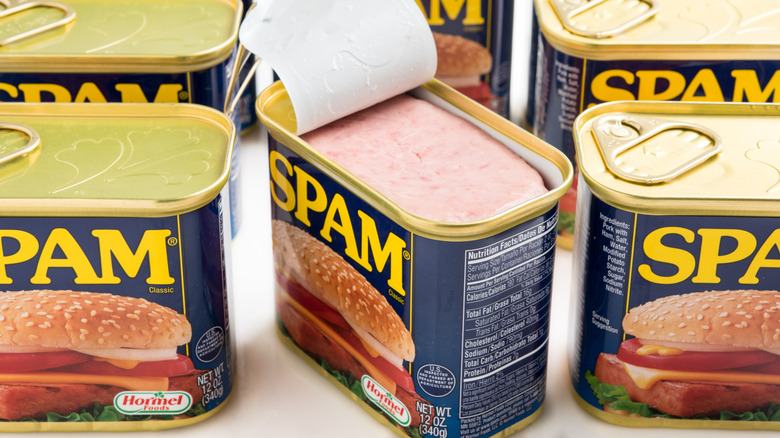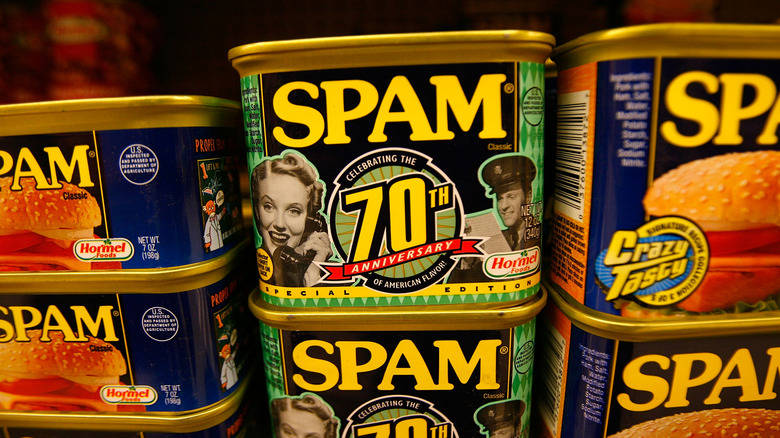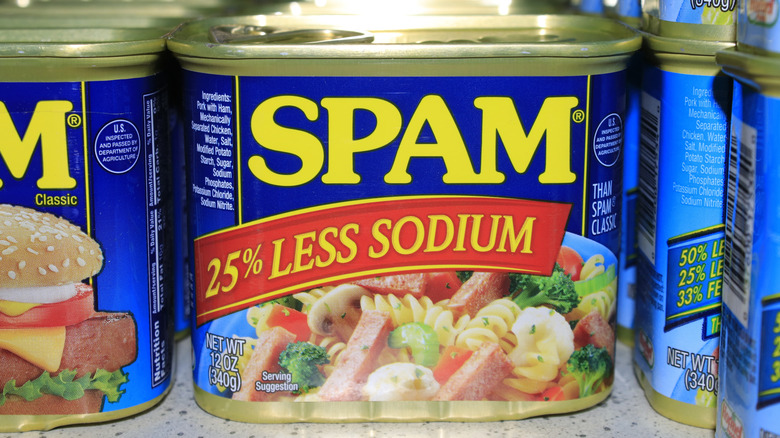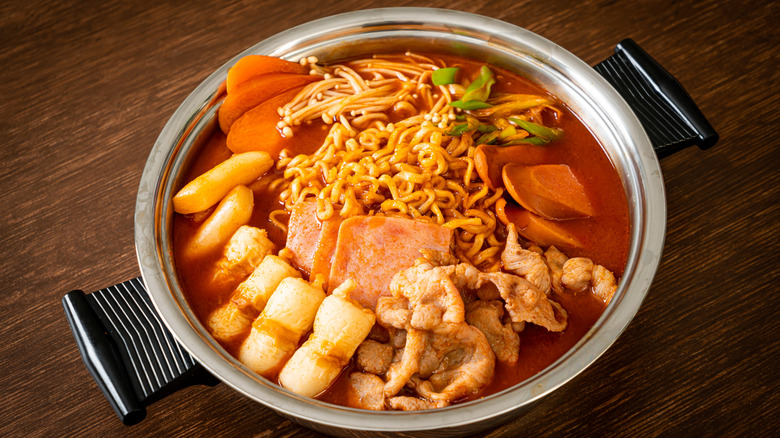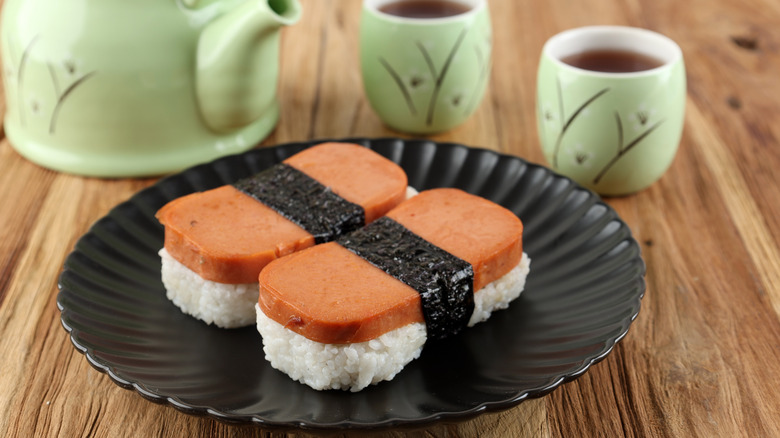The Ultimate Guide To Spam And How To Cook With It
We may receive a commission on purchases made from links.
Spam has had a real resurgence recently. This Hormel Foods canned meat product used to be a laughing stock, and the kind of thing you'd only eat if you were out of any other options. Now, though, it's the hottest ingredient in town. A combination of viral videos using Spam and people realizing that it can be used in pretty much anything has led to its sales skyrocketing, bolstered by growing awareness of Spam's unique place in various food cultures. It's also led to folks questioning, once again, what Spam actually is and what you can do with it in the kitchen.
We don't blame you for wondering too. Open a tin of Spam and you'll be greeted with a pale pink mass of mysterious meat, which will doubtless lead to questions about what's inside this product and how to cook with it. Luckily, we've got answers to every question you've got about Spam, and we roped in some experts to help us out. We spoke to Rachel Burnett, senior account executive at Burson Global, a communications agency that works with Hormel Foods; Food Network star and Michelin Award winner Chris Oh; and Jeff Wang of Ono Hawaiian BBQ. Together, they filled us in on all things Spam, and how you can turn this canned product into a culinary delight.
Spam was invented just before WWII
Spam has truly stood the test of time. The canned meat is arguably more popular today than ever — not bad for a product that was invented nearly 90 years ago. "The first can of SPAM rolled off the production line on July 5, 1937," says Rachel Burnett. It was originally conceived as a way to use up pork shoulder, a neglected cut, that allowed Hormel to make an inexpensive meat product that would remain shelf-stable for months, and which could be used in versatile, innovative ways.
Spam really came into its own during the war years, when it allowed folks to get some much-needed meat and nutrition when fresh ingredients were harder to obtain. Its popularity was driven by Hormel's involvement in the war efforts. "As the United States entered WWII, Hormel provided 15 million cans of food to troops each week. SPAM immediately became a consistent part of soldiers' diets," explains Burnett, who notes that once the troops returned to their families after the war, they brought their love of Spam with them. The canned meat's appeal has been firmly established ever since.
The origins of Spam's name are a mystery
One of Spam's main selling points is its unique name, which immediately sticks in your mind. Where does that name come from, though? The truth is that no one knows. "This is always a fun one to answer — it's a secret!" says Rachel Burnett. While the true meaning of the name remains a mystery, Burnett did treat us to the origin story. "Back at a Hormel New Year's Eve party in 1936, Ken Daigneau, who was a brother of a Hormel Foods vice president, won a contest — and $100 — for coming up with the name "SPAM" for the brand." We're willing to bet that once Spam became as popular as it did, Daigneau felt a little short-changed by the amount of money he walked away with.
Debate still rages on where the actual name comes from. Burnett points out that a lot of people think that Spam is "a shortened version of 'spice ham'" — a theory which was allegedly backed up by Jay Hormel himself. This may well be a false fact about Spam that we've just all bought into, though, and the fact that it doesn't contain any spices, or indeed much ham, seems to contradict this. Other folks believe that the name actually comes from an acronym for "Shoulder of Pork and Ham," which does seem to make sense. No one can quite be sure how Spam got its name at this point, but hey, it's fun to guess, right?
Spam has fewer ingredients than you might think
There are a lot of misconceptions about Spam, but one of the main ones is that it's some kind of mystery meat that's been pumped with countless ingredients. In fact, its ingredients list is both short and identifiable. "SPAM is made from six simple ingredients: pork with ham, salt, water, potato starch, sugar and sodium nitrate," explains Rachel Burnett. The pork and ham are the base of the product, with the water loosening things up, and the salt and sugar providing flavor. The potato starch, meanwhile, keeps the product cohered together and gives it its smooth texture, while the sodium nitrate acts as a preservative.
Importantly, this is just the base recipe for regular Spam, and differently-flavored Spams will probably contain some additional ingredients. Spam Maple Flavored, for example, also contains Natural Maple Flavor, while Spam Oven Roasted Turkey, as you might expect, uses turkey as its base ingredient. The latter also has turkey broth to give it a richer flavor. It's worth pointing out that there's no getting away from the fact that the meat in Spam is pretty heavily processed, no matter which version you're going for. However, that processing doesn't involve it being slathered in endless additives and preservatives.
Classic Spam is high in sodium and fat — but alternatives are available
Spam gets a pretty bad rep for its nutritional quality, and honestly, there's no getting around certain levels of ingredients in it. When it comes to sodium and fat, classic Spam is hardly the best option out there. A small 56-gram serving of Spam (roughly ⅙ of a normal-sized can) supplies 790 milligrams of sodium, which covers approximately a third of your daily value. On the fat side, it provides 6 grams of saturated fat, accounting for 30% of your recommended daily value, and 16 grams of fat overall.
However, Hormel has clearly thought about the nutritional impact of its flagship item, and luckily there are other options. Rachel Burnett points out that Spam Lite and Spam 25% Less Sodium could be good options for folks who are looking to make healthier choices. Spam 25% Less Sodium keeps the fat content the same, but reduces the sodium content to 570 milligrams per serving. Spam Lite, on the other hand, cuts fat and sodium from the product, with one serving delivering 570 milligrams of sodium, 8 grams of total fat, and just 3 grams of saturated fat. Crucially, it does so without sacrificing taste: People love this Spam product.
Spam's popularity in Korean cuisine goes back to WWII
Spam is one of the most American products out there, but its flavor and ease of transport have allowed it to travel the world. It's gained particular popularity in Korean cuisine, where it's long been considered a luxury. "Growing up, SPAM to me was like how the American culture grew up with bacon — every [chance] I had to have SPAM in a meal was always a bonus in our household," explains Chris Oh. Its appeal in Korea has made the country the second-largest purchaser of the meat product, after America.
So where does Spam's popularity in Korea stem from? It all dates back to the WWII, when American soldiers were stationed in South Korea, and took the product with them. "During the war, cans of Spam were sometimes donated by soldiers or smuggled off military bases and used in local Korean cooking," says Rachel Burnett. Word spread about this new meat product, and it was quickly incorporated into Korean cuisine. Now, "Spam has become a staple of South Korean culture, leading to the creation of buddae jjigae, or 'army stew,' which has become a comfort food within Korean cuisine," she mentions. "Additionally, premium black-label packages of Spam are often gifted during Korea's Chuseok celebrations."
Spam is a super versatile ingredient
One of the biggest questions that first-time Spam users have is how you cook it, and what you can use it in. The answer? Any way you want, and in pretty much anything. "Spam is a versatile protein that can replace other protein options in various dishes," says Jeff Wang. Chris Oh shares that sentiment, saying, "Spam is such a versatile ingredient," with its easy flavor and blocky shape making it a breeze to cut and incorporate however you see fit.
Wang points out that Spam "can be used instead of grilled chicken or beef in rice bowls or as a filling in sandwiches," but things don't have to stop there. You can put Spam in curries, roll it into puff pastry to make Spam in a blanket, and even throw it into some Spam tacos. Sometimes, though, it really pays to keep things simple. "I'm a purist! I just like to fry it in a pan and eat it with some simple rice, eggs and A1 sauce," says Oh. Sounds like a pretty good meal to us.
Spam is particularly popular in Hawaii
Spam is eaten all across the United States, but there's one place where it's particularly well-loved: Hawaii. As with the adoration of Spam in South Korea and other Asian countries, it all comes back to the Second World War. American soldiers who were stationed in Hawaii would commonly eat Spam, and the product gradually made its way beyond the barracks and into the local cuisine. This, of course, was aided by the fact that Spam could be transported thousands of kilometers to Hawaii without spoiling. As Jeff Wang notes, "Spam became a beloved staple in Hawaii due to its shelf stability and versatility."
Nowadays, you can find Spam incorporated into loads of different recipes. "Spam is featured in dishes like Spam Musubi and is often included in plate lunches," says Wang. A local favorite is also Spam Fried Wontons, which combine Spam, water chestnuts, and seasonings in crispy wonton shells. Plus, if you're ever in a McDonald's around breakfast time in Hawaii, you can grab yourself a plate of Spam, Eggs, and Rice. This local staple gives you all the delicious flavor you'd normally get from bacon, and puts a distinctly Hawaiian twist on things.
Spam is uniquely suited to the air fryer
You can cook Spam in pretty much any way you like, by frying it, baking it, or even by poaching it (hey, don't knock it, it's surprisingly good). If you want to make the most of your Spam, though, you need to bust out the air fryer. "Spam can be air-fried, making it a great option for a crispy addition to meals," says Jeff Wang. Rachel Burnett agrees with him, pointing out that air-frying Spam is just as good as popping it in the skillet, and just as easy to do as well.
The beauty of air-frying Spam is that you don't really need to add that much to it. It's salty enough to get away with air frying without being seasoned (although you can throw on any herbs and spices that you want), and its fat content means that it remains juicy and moist without you needing to douse it in loads of oil. "You can slice Spam and air-fry it for use in a Spam musubi or as a crunchy topping on a rice bowl," says Wang. You can also make Spam fries in your air fryer, and do so incredibly easily. You just need to cut them into fry shapes and pop them in your appliance for 10 minutes.
You can even use Spam in salads
Spam is hardly considered a healthy food, but that doesn't mean it can't be used in slightly healthier ways. You don't need to deep-fry Spam in pastry or flood it with salty, sticky sauces — it can also be your star protein in a host of salads. Jeff Wang likes to throw Spam in his macaroni salad to give it extra depth. "Mix in diced Spam to create a rich, savory version that complements grilled meats, just like in many Hawaiian BBQ plates," he recommends.
You add Spam to simple green salads too, to give them an umami punch and way more bulk, as well as substituting it for chicken in a Caesar salad. Spam's rectangular shape also makes it the perfect addition to a chopped salad, thanks to the ease with which you can cut it down to the appropriate size. Whatever way you use it in your salad, just bear in mind that it will bring a lot of sodium to the table. It's best to avoid using ultra-salty, sharp salad dressings, or you may end up making your meal taste too briny.
